Archive for September, 2021
[WEB] Play Video Games, Rehab Less
Posted by Kostas Pantremenos in REHABILITATION, Video Games/Exergames on September 30, 2021
Posted by Deborah Overman
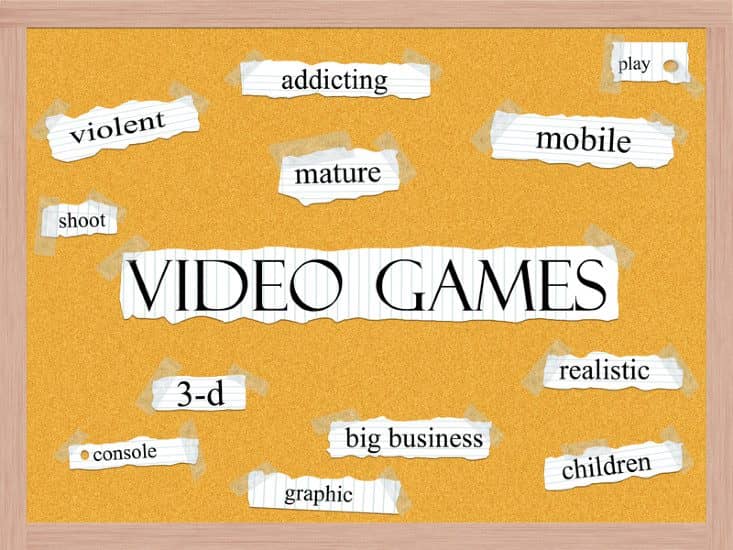
Academic and engineering experts from the University of Strathclyde and the National Manufacturing Institute Scotland (NMIS), have teamed up with UK and European partners to reduce rehabilitation times for patients with stroke, dystonia and sports injuries by up to 30% using video game-style technology.
Funded by the European Commission as part of Horizon 2020, an initiative to drive economic growth through research, the 2-year PRIME-VR2 project will create a digital environment using virtual reality (VR) within rehabilitation programs.
The technology aims to improve rehabilitation speed and completion rates by making it more stimulating and will complement traditional rehabilitation methods while also easing the physical demands placed on occupational and physical therapist practitioners, a media release from National Manufacturing Institute Scotland explains.
PROGRESS BY COMPLETING ONLINE GAMES
Structured as a level-based system where patients must complete online games to make progress, the digital platform allows medical staff to track patient progress using gaming data and provide ongoing support virtually.
The technology will help patients develop upper body motor skills to improve movement in their arms, wrists, hands, and fingers and provide personalized activities depending on their unique cognitive and physical impairments. For example, those with the neurological movement disorder dystonia can practice pouring a glass of water in the virtual world without spilling a drop in reality.
The University of Strathclyde and NMIS are supporting industrial partners, Loud1Design with the development of the virtual program and a prototype bespoke video game controller. The controller will be custom made for each patient according to their condition and personal requirements using additive manufacturing, a form of 3D printing where an object is built one thin layer at a time, allowing for customization.
Coordinated by the University of Pisa, the project includes other academic partners such as the Universities of Malta and Oulu, University College London, and industry partners from the technology and gaming world. Saint James Hospital, Kinisiforo & NICOMED Rehabilitation Centre, and the Global Disability Innovation Hub are providing patient requirements and will monitor progress when the prototypes are complete.
“We are extremely pleased to be working alongside the consortium on this exciting venture, improving rehabilitation for patients using virtual reality games suited to their individual needs.
“The outcome of this project will make the long recovery process more engaging while permitting the patient’s performance to be recorded accurately, allowing specific and measurable goals to accelerate rehabilitation time. We are all looking forward to the completion of the project, as it will provide a significant milestone for interactive technology in improving physical health and performance.”
— Andrew Wodehouse, Senior Lecturer at the Department of Design, Manufacturing and Engineering Management at the University of Strathclyde, and founder of the European Consortium
Kareema Hilton, Manufacturing Engineer at the National Manufacturing Institute Scotland said: “This is a fantastic project that is allowing us to use developments within digital technology to potentially improve healthcare. The use of additive manufacturing demonstrates the benefits of a flexible design that can be made bespoke to an individual user – in this case to support an individual’s physical needs to assist rehabilitation.
“We’re working closely with our colleagues in the University of Strathclyde and the wider consortium, bringing expertise from a variety of backgrounds to ensure that the virtual platform and physical controller are fully reflective of each patient’s requirements.”
— Kareema Hilton, Manufacturing Engineer at the National Manufacturing Institute Scotland
“I’m delighted to be working on this project alongside Dr Wodehouse and the teams involved. Their human-centered design approach aligns well with my commercial design practice, and PRIME-VR2 is strengthening our industrial-academic collaboration. The expertise and resources from NMIS will allow us to push the envelope of additive manufacturing and responsive design in the delivery of these bespoke VR controllers.”
— Brian Loudon, Loud1Design Owner
[Source(s): National Manufacturing Institute Scotland, News-Medical Life Sciences]
[ARTICLE] Effects of a Novel Movement-to-Music (M2M) Intervention on Physical and Psychosocial Outcomes in People Poststroke: A Randomized Controlled Trial – Full Text
Posted by Kostas Pantremenos in Music/Music therapy, REHABILITATION on September 30, 2021
Abstract
Objective
To investigate effects of a 12-week movement-to-music (M2M) intervention on physical and psychosocial outcomes in people poststroke.
Design
Two-arm randomized controlled trial.
Setting
A community-based fitness facility.
Participants
Participants (N=47) with stroke between 18 and 65 years old were randomized to M2M (n=23) or waitlist control (n=24).
Interventions
Participants in M2M completed three 60-minute exercise sessions per week for 12 weeks. Controls received biweekly educational newsletters via mail.
Main Outcome Measures
Primary outcomes included Six-Minute Walk Test (6MWT, in meters), Five Times Sit-to-Stand Test (FTSST, in seconds) and Timed Up and Go (TUG, in seconds). Secondary outcomes were self-reported measures using PROMIS Fatigue and Pain Interference Short Form 8a. Outcomes were collected at baseline and post-intervention. Analyses involved descriptive statistics and adjusted linear mixed models.
Results
Mixed models adjusted for the respective baseline values and demographic variables showed that M2M participants had longer 6MWT distance (LSM difference [95% CI]=14.5 [-12.9, 42.0]), more FTSST time (2.0 [-4.5, 8.5]), and less fatigue (-3.0 [-7.2, 1.2]) compared to control post-intervention. When controlling for baseline TUG and demographic variables, there were larger increase in 6MWT distance (37.9 [-22.7, 98.6]), lower FTSST time (-6.1 [-18.5, 6.2]), and decrease in fatigue (-6.5 [-13.1, 0.2]) in M2M compared to controls. Moderate effect sizes were observed for improving 6MWT (d=0.6), FTSST (d=-0.6), and fatigue (d=-0.6). There was no group difference in change in TUG time and pain interference, with trivial effect sizes (d=-0.1).
Conclusion
Movement-to-music may be a valuable exercise form for adults with stroke. Future studies are needed to determine optimal exercise doses for improving health and function in this population.
———————————————-
Stroke is a leading cause of disability worldwide resulting in one or more physical and/or cognitive impairments1-5 which is often accommodated by sensory, perceptual, emotional, and social conditions that may impact quality of life6-8. Regular exercise has been recognized as a critical behavior for chronic disease prevention and overall health improvement in the general population9,10. For people poststroke, exercise can also be beneficial with evidence demonstrating its positive effects on physical function11, cognition12, and quality of life11,13-16. It may also reduce the risk of further cardiovascular events including a recurrent stroke13,15,17-19. Despite these benefits, many people poststroke do not engage in sufficient physical activity to receive health-enhancing benefits20. English et al. investigated sitting and physical activity and reported that adults poststroke spent significantly more time sitting and less time performing transportation, household, and leisure activities compared to their age-matched healthy counterparts21. Therefore, it is imperative to identify strategies to promote engagement in physical activity among people poststroke.
Enjoyment remains an important aspect of an exercise intervention as individuals are more likely to continue their exercise regimen after the intervention ends22. However, there are few evidence-based programs for people poststroke that extend beyond conventional exercise modalities that involve repetitive movements such as stationary arm or leg cycling23,24. Incorporation of music within an exercise program has the potential to enhance engagement and performance25. In fact, a meta-analysis has demonstrated that music-supported therapies can be effectively used to enhance physical function in people poststroke26. Potential explanations for improvements in physical function could include enhanced motivation and engagement or even positive neuroplastic changes27,28. To date, there are only a few dance-based or rhythmic exercise programs that aim to improve physical function and quality of life in people poststroke29,30. The use of music to facilitate exercise remains one underutilized modality.
There is a need to provide alternative forms of exercise that can positively impact the physical function and health of people poststroke. Movement-to-Music (M2M) was created for people with disabilities as a novel rhythmic-based exercise intervention that uses combinations of movement patterns choreographed with music. M2M targets four training components: range of motion, muscle strength, cardiorespiratory fitness, and balance. In a previous M2M trial31, participants with multiple sclerosis demonstrated improvements in mobility and walking endurance after a 12-week intervention. Given that people poststroke experience similar benefits from exercise as people with multiple sclerosis23,24, the potential benefits of M2M for people poststroke warrant investigation. Thus, the purpose of this study was to examine the effects of M2M31 on health and functional outcomes in adults poststroke.[…]
[ARTICLE] Identification of Good Practices in Long-Term Exercise-Based Rehabilitation Programs in Stroke Patients – Full Text
Posted by Kostas Pantremenos in REHABILITATION on September 29, 2021
Abstract
Physical activity is an important factor for primary and secondary stroke prevention. The process of stroke rehabilitation includes early and late physical activity and exercise, which prevents further stoke and improve patients’ quality of life. MY WAY project, an ERASMUS+ SPORT program, is aimed at analyzing and developing or transferring best innovative practices related to physical activity and exercise enhancing health in poststroke patients. The aim of the study was to identify, analyze, and present the good practices and strategies to encourage participation in sport and physical activity and engage and motivate chronic stroke patients to perform physical activity changing their lifestyle and to maintain a high adherence to long-term exercise-based rehabilitation programs. Our results demonstrated that unified European stroke long-term exercise-based rehabilitation guidelines do not exist. It seems that low training frequency with high aerobic exercise intensity may be optimal for improved physical performance and quality of life in combination with a high adherence. It is important to optimize the training protocols suitable for each patient. The continuous education and training of the specialized professionals in this field and the presence of adequate structures and cooperation between different healthcare centers are important contributors. The clear objective for each country should be to systematically make the necessary steps to enhance overall exercise-based stroke rehabilitation attendance in the long term. Long-term interventions to support the importance of physical exercise and lifelong exercise-based rehabilitation in chronic stroke patients should be created, what coincides with the goal of the MY WAY project.
1. Introduction
Due to the aging of the population and the increased prevalence of chronic diseases, such as diabetes mellitus, hyperlipidemia, and hypertension, there is a significant rise in stroke incidence among European countries and worldwide, during the last decades [1, 2]. Together with the welcome improvement in the survival rates, the number of people who have had a stroke and must live with its consequences needing specialist supportive care and rehabilitation is increased [3, 4]. Stroke survivors can experience a wide range of negative physical and mental consequences that are long lasting, including problems with mobility, vision, speech, and memory; personality changes; cognitive impairments; fatigue; and depression. Poststroke problems affect patients’ ability to complete daily activities at home and to participate in the community [5].
An effective health care planning and adequate resource allocation across Europe is needed to deal with the rising number of people living with the long-term effects of stroke. In particular, access to rehabilitation therapy, mainly postacute care, must be improved. The hope is that in Europe everyone gets the long-term support they need to regain as much independence as possible.
Long-term exercise-based rehabilitation is aimed at enabling people with disabilities to reach and maintain optimal physical, intellectual, psychological, and/or social function. European stroke care guidelines make recommendations for the elements of rehabilitation [6], although there is not enough evidence to ensure the exact content of the recommended therapies. Additionally, there is no uniform approach in the EU and no common exercise-based stroke rehabilitation protocol is suggested among the European countries [7, 8]. Nevertheless, physical activity and exercise are highly recommended in the chronic phase to sustain functions gained in rehabilitation and as part of long-term secondary prevention to reduce the risk of recurrent stroke and other vascular events [9, 10].
Research suggests that stroke patients may benefit from early exercise training aiming to enhance their exercise capacity, help prevent further strokes, and improve patients’ quality of life [11, 12]. It seems that exercise training has multiple mechanisms of action. Several studies have shown that exercise training could protect the brain from stroke injury by mechanisms involved in the regulation of cerebral edema, cellapoptosis, oxidative injury, and stem cell [13]. In addition, it has been demonstrated that exercise facilitates neuroplasticity by promoting the compensation of surviving brain areas; improving interhemispheric connections; increasing synaptic plasticity through regulating neurotrophins, synaptic activity, and structure; and accelerating neuronal reorganization and regeneration [14]. A systematic review evidence showed that exercise interventions are beneficial for patients with a number of conditions that are comorbid conditions or risk factors for stroke, by improving vascular risk factors in obesity and type II diabetes, reducing blood pressure, and improving cardiovascular mortality and depressive symptoms [12]. Hence, development of new interventions is needed to help stroke survivors achieve a more active lifestyle to maintain the functional levels achieved during stroke unit treatment and early poststroke rehabilitation [15]. MY WAY project, which is an ERASMUS+ SPORT program that involves experts from Croatia, Czech Republic, Greece, Italy, and Lithuania, is aimed at covering this gap. MY WAY project seeks to develop, implement, and transfer innovative practices related to physical activity and exercise enhancing health in poststroke patients. To achieve this goal, the identification of good practices in the field of long-term exercise-based rehabilitation is important. The aim of the present study was to identify, analyze, and present the good practices and strategies to encourage participation in sport and physical activity and engage and motivate chronic stroke patients to perform physical activity changing their lifestyle and to maintain a high adherence to long-term exercise-based rehabilitation programs.[…]
[Abstract] Designing an app for home-based enriched Music-supported Therapy in the rehabilitation of patients with chronic stroke: a pilot feasibility study
Posted by Kostas Pantremenos in Apps, Music/Music therapy, Tele/Home Rehabilitation on September 29, 2021
ABSTRACT
Objective
After completing formal stroke rehabilitation programs, most patients do not achieve full upper limb motor function recovery. Music-supported Therapy (MST) can improve motor functionality post stroke through musical training. We designed a home-based enriched Music-supported Therapy (eMST) program to provide patients with chronic stroke the opportunity of continuing rehabilitation by themselves. We developed an app to conduct the eMST sessions at home with a MIDI-piano and percussion instruments. Here, we tested the feasibility of the eMST intervention using the novel app.
Method
This is a pilot study where five patients with chronic stroke underwent a 10-week intervention of 3 sessions per week. Patients answered feasibility questionnaires throughout the intervention to modify aspects of the rehabilitation program and the app according to their feedback. Upper limb motor functions were evaluated pre- and post-intervention as well as speed and force tapping during daily piano performance.
Results
Patients clinically improved in upper limb motor function achieving the Minimal Detectable Change (MDC) or Minimal Clinically Important Difference (MCID) in most of motor tests. The app received high usability ratings post-intervention.
Conclusion
The eMST program is a feasible intervention for patients with chronic stroke and its efficacy should be assessed in a clinical trial.
[WEB] How Exercise Helps the Depressed Brain
Posted by Kostas Pantremenos in Depression, Neuroplasticity on September 29, 2021
Physical activity restores neuroplasticity and can reduce depressive symptoms.
KEY POINTS
- Deficits in neuroplasticity—the brain’s ability to change and adapt—are a hallmark of clinical depression and major depressive disorder (MDD).
- New research suggests that a three-week physical activity intervention can restore deficient neuroplasticity in patients with MDD.
- Physical activity can reduce depressive symptoms, the study shows, but it’s unclear if restored neuroplasticity causes this clinical effect.
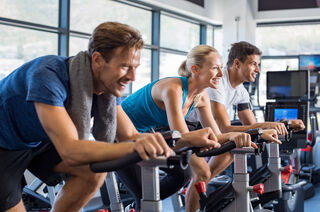
A recent study (Brüchle et al., 2021) from Ruhr-Universität Bochum’s Clinic for Psychiatry and Psychotherapy in Germany shows that a three-week physical activity intervention supports the remission of major depressive disorders (MDD) and normalizes long-term potentiation (LTP) neuroplasticity in MDD patients.
Although these two observations (reduced clinical symptoms and restored neuroplasticity) are highly correlated, the researchers aren’t 100 percent certain that restoring brain plasticity via exercise causes the remission of depressive symptoms. This open-access paper was recently published in the peer-reviewed journal Frontiers in Psychiatry.
For this study, senior author Karin Rosenkranz and her RUB colleagues recruited 41 adults undergoing treatment for MDD at their clinic. Participants were randomly divided into an “exercise group” and a “non-exercise” group. As the authors explain, “We investigated the effect of a 3-week physical activity (PA) program applied on clinical symptoms, motor excitability and plasticity, and cognition in patients with MDD (N = 23), in comparison to a control intervention (N = 18).”
Before and after the physical activity interventions, depression severity was measured using the second edition of the Beck Depression Inventory (BDI-II) rating scales. The BDI-II is a 21-item self-report inventory that measures the severity of depressive symptoms, such as negative feelings, pessimism, hopelessness, a loss of passion and desire, or a lack of motivation and drive.
To test LTP-like neuroplasticity, Brüchle et al. used a combination of transcranial magnetic stimulation (TMS) protocols, short-interval intracortical inhibition (SICI), and paired-associative stimulation (PAS) described here.
The researchers found that higher baseline BDI-II scores were correlated with lower levels of neuroplasticity. However, after three weeks of regular physical activity, study participants in the “exercise group” had much lower BDI-II scores (which reflects less severe depression) and higher levels of neuroplasticity; the control group stayed closer to baseline.
When People with Major Depression Exercise, Neuroplasticity Improves and Depressive Symptoms Subside
“The more [neuroplasticity] increased, the more clearly the clinical symptoms decreased,” Rosenkranz said in an August 2021 news release. “These changes were not so pronounced in the group who took part in the control program. This shows that physical activity has an effect on symptoms and the brain’s ability to change.”
However, she emphasizes that these correlative findings do not imply causation. “We cannot say to what extent the change in symptoms and the brain’s ability to change are causally linked based on this data,” Rosenkranz noted. “It is known that physical activity does the brain good, as it, for instance, promotes the formation of neuron connections. This could certainly also play a role here.”
The authors sum up their findings in the paper’s discussion section:
“In summary, we showed that a physical activity (PA) intervention supports the remission of clinical symptoms and normalizes deficient LTP-induced neuroplasticity in MDD and that these two observations are highly correlated. Our study, therefore, further highlights the role of neuroplasticity in the pathophysiology of MDD and PA in its treatment by showing that this intervention directly targets deficient neuroplasticity as an underlying pathophysiological mechanism. Further research is needed to explore whether the effect of therapeutic interventions might be predicted by clinical or neurophysiological parameters, as this would support the development of individualized treatments strategies.”
The latest “exercise and depression” research (2021) identifies a correlation between regular physical activity, improved depressive symptoms, and restored neuroplasticity in patients with MDD. More research is needed to identify causal links and establish the clinical relevance of neuroplasticity-enhancing exercise interventions for treating major depressive disorders.
LinkedIn image: TORWAISTUDIO/Shutterstock. Facebook image: Rido/Shutterstock
References
Wanja Brüchle, Caroline Schwarzer, Christina Berns, Sebastian Scho, Jessica Schneefeld, Dirk Koester, Thomas Schack, Udo Schneider and Karin Rosenkranz. “Physical Activity Reduces Clinical Symptoms and Restores Neuroplasticity in Major Depression.” Frontiers in Psychiatry (First published: June 09, 2021) DOI: 10.3389/fpsyt.2021.660642
About the Author
[WEB] The Role of the Caregiver: Five Things to Know
Posted by Kostas Pantremenos in Caregivers on September 28, 2021

By Stephen Friedhoff, MD, chief clinical officer for Help at Home
Every day, thousands of seniors and their families are faced with making decisions about how to care for themselves or their loved ones. For many people, finding a solution to staying in home is the right choice, as most seniors prefer to live as independently as possible in their own home.
With the right support, aging at home is a viable solution that provides benefits and advantages versus nursing homes or assisted living facilities. For example, in-home supports greater independence at a lower cost and often with better health and quality of life outcomes–especially when the client and the caregiver have an established relationship. At home, individuals who need assistance with activities of daily living may find not just the physical assistance they need, but also the emotional and psychological support to have great days.
Finding the right match better ensures a strong and long-lasting relationship between the caregiver and the client. When the client and caregiver “click,” it enhances the caregiver’s ability to be the eyes and ears of the client. This helps to identify issues that can predict and reduce avoidable adverse incidents in the home such as falls, medication errors, loneliness, etc. All of these are known risks for hospital admissions, institutionalization and even increased risk for disability and death.
How do you choose the right caregiver who can help your loved one live happily in their homes and have great days? Here are five important qualities to look for in a caregiver to help ensure the match is right, and to enhance the relationship between your loved one and the person who provides care:
- Compassionate
Care should be provided in a way that the patient feels like a partner in the process. Clients respond best when their caregiver genuinely understands and acknowledges their fears and concerns. Genuine compassion and empathy also strongly influence patient engagement and satisfaction.
- A Good Listener
A caregiver who listens to understand creates a sense of trust between client and caregiver. A caregiver who listens shows a client that their voice matters – that caregiver is also in a unique position to learn more from the individual they serve, while gaining their trust in the process. They may be the first person to know that the client feels tired, has recently fallen or perhaps that they aren’t taking a new medication because it makes them feel poorly. That level of openness and trust enables the caregiver to be one of the client’s best advocates.
- Understanding
A skilled caregiver can balance a commitment to a client’s care plan and support of the individual in their own journey to well-being. A caregiver has a unique perspective that supplements the client’s family in some instances. Often, family members struggle with deeply established family dynamics, which even when well-intended, can interfere with supporting the client when new challenges arise that affect mobility, accessibility, safety, and hygiene. An understanding caregiver can introduce a fresh approach that supports all parties involved.
- Observant
Keen, non-judgmental observation is an important skillset for a high-quality caregiver. An observant caregiver can provide awareness to the client’s loved ones about safety and health concerns in the environment. They can also discern subtle changes in mood, mobility, or appetite that help detect more concerning/substantive issues early to allow timely interventions.
- Companionship
Social interaction is fundamental to good health. People with multiple health care challenges are more likely to be socially isolated and lonely, which are strongly associated with poor health outcomes. A companion in the form of a caregiver is an ideal way to interrupt that pattern. A skilled caregiver can help an individual enjoy a great meal, a fun board game, a shared conversation, or a walk in the park. And help the client look forward to the next visit.
It’s important for individuals and their families to have high expectations for their caregiver. Be sure to look for these five qualities in the person you trust with your care.
Dr. Stephen Friedhoff is chief clinical officer at Help at Home. He previously served as enterprise chief clinical officer and in other leadership roles for Anthem Blue Cross Blue Shield. Before that, he was a practicing family medicine physician.
For more information, visit Help at Home.
[Source: Help at Home]
[BLOG POST] Free Stuff for Adults with Disabilities (and/or Special Needs)
Posted by Kostas Pantremenos in Caregivers on September 28, 2021

Adults with disabilities: 25 years old and older. For people younger than 25, click HERE to go my post on Free Stuff for Kids with Disabilities
This article is all about free stuff for adults with disabilities (and/or special needs*) Why? Because there are a more than a few lists of free things, resources and help out there for kids with disabilities (and/or special needs*), but I’m not sure I’ve ever seen one for adults with disabilities.
Which is either flattering or really depressing. Flattering, because it implies that we adults with disabilities have it all together and don’t need help, or depressing because there just isn’t much out there, and resources think that they are promoting them so well that lists of this type don’t seem necessary.
Either way you have it, I think it’s time to compile a handy list, and to update it as often as possible.
In This Post You Will Find: [show table of contents]
Scholarships
Personal story: I was kicking myself after I completed graduate school (on my own dime, time and with private loans) and found out that being deaf is considered a disability! As an honors student straight through, I could have easily gotten a scholarship, but I had no idea that I counted as “disabled”. Don’t be like me. Check these out:
JLV Counseling’s Clearinghouse of Scholarships for People with Disabilities: Comprehensive list of scholarships available to people with disabilities, categorized by disability.
Ruby’s Rainbow: Scholarships for people with Intellectual Disabilities to attend higher education.
Department of Vocational Rehabilitation: the point of DVR/DOR is to help people with disabilities find and keep jobs that suit them. If you need higher education in order to find and keep a job that suits you, DVR/DOR should help. This is not a rule but it is definitely an avenue to explore.
Financial Aid at Your Local University:
- sit down with a financial aid counselor (not a student helper!) and request information on all relevant grants, scholarships, opportunities, etc related to disability.
- meet with the disability services at your local university and request all information related to grants, scholarships, opportunities, etc.
- meet with the career counselor who works with disability/disability services at your local university and request information related to grants, scholarships, opportunities, etc. They might also have information on work opportunities.
Financial Planning
Financial planning is incredibly important for us adults with disabilities. Here are some free resources to help:
ABLE Account: understand the ABLE accounts. We can save money in an account that will not go against SSI/SSDI.
The Red Book: on the heels of understanding ABLE accounts is “The Red Book” – Social Security’s annual book on benefits. The link provided is to a pdf of the book.
Disability Benefits 101: tools and information on employment, health coverage, and benefits. Not all states are set up with the calculator, but World Institute on Disability has a lot of other information on financial planning and benefits – check out their books and resources here.
PASS Plans: “A Plan for Achieving Self-Support (PASS) allows a person with a disability to set aside otherwise countable income and/or resources for a specific period of time in order to achieve a work goal. Any person who receives SSI benefits,or who might qualify for SSI, or any person receives SSDI (or a similar benefit) and could qualify for SSI, may be able to have a PASS. There is no limit to the number of successful PASS plans a person may use in a lifetime.”
Free Passes
National Park Service: free lifetime pass to US national parks and more. There are some requirements and stipulations, so read through the application – which is linked here.
State Park Service: state parks have a disability discount – look up your state for more information and for the application. California’s is linked here.
Disney Disability Pass: this is changing as a result of the abuse, but it still helps us adults with disabilities.
Travel
I’m deaf, with PTSD & TBI and I have never had much money. I’m also a travel junkie. I have found ways to travel the world for free or cheap on numerous occasions.
Obviously, my travel parameters are going to be different from those who have disabilities different from mine – I don’t use a wheelchair, I don’t use an attendant, and I can speak for myself.
BUT the first rule of travel is something like, “If you don’t believe it, nobody will.”
You have absolutely got to hold tight to what you want and what your vision is. There is a way to accomplish it, if you are willing to do the research to figure out how to make it happen (on a dime that is not yours).
Here are some places to start:
MIUSA: Mobility International. These guys are awesome – I want to work for them! They have a ton of information on traveling abroad, financial resources, etc, listed clearly and cleanly in their fantastic website. They also have staff that you can contact with more direct and trip-specific questions. I did, when we were going to Mexico, and they were helpful. Furthermore – they have information for Americans going abroad and people outside the US coming to the US.
The Foundation Center: search foundations to apply for funds. Don’t forget your intersections – that is, if you are poor or a female or a racial minority or LGTBQ, search under those groups as well for foundations that apply to you.
Transitions Abroad: one of the king-beasts in websites for living/working abroad (along with Dave’s ESL Cafe) – definitely opportunities to find free ways to travel or jobs.
Google: I don’t mean to be flippant, but you have to research. A simple query of “free travel” led to this good (and recent) article.
Articles like that are good but don’t feature people who use wheelchairs in the photos, nor do they have people walking around using canes and service dogs! Here we go back to the first rule: “If you don’t believe it, nobody will.” You have to see yourself doing what you want to do, and really believe you can do it – and then reach out. Do you disclose? Do you have to? You can treat a lot of these travel opportunities as a job, and use JAN’s handy disclosure articles to help you. Linked here.
Medical
Deshae Lott Quality of Life Grants: “works to help American citizens with severe mobility limitations maintain hopeful, purposeful, engaged lives by providing some financial support for medically-necessary home-health-care services not covered by insurance, private or governmental, and not covered by any other non-profit organization.”
Medicaid: from a friend, “the full range of benefits from medicaid sometimes goes overlooked. they will pay for changes in your house so it is more accessible (5k every 5 years), they offer rides to appointments, reimbursement for travel to appointments, a case worker you can contact directly, and in-home caretaker hours..”
Easterseals: I feel a little guilty putting this in because the site is so vague and huge. Evidently though, they can be useful? You are supposed to find the branch office close to where you live, and see what they are able to offer you. Sounds like fun!
REquipment: wow, ’bout time. Used medical equipment, for free, without hassle from insurance.
Department of Vocational Rehabilitation: the point of a DOR/DVR is to help people with disabilities find and keep jobs. If you need some medical equipment (or something along those lines) in order to find and keep a job, they will usually help you. I got my digital hearing aids that way, years ago, and those bubbas aren’t cheap.
Assistive Technology
Department of Rehabilitation: The point of DOR/DVR is to help people with disabilities find and keep jobs (I know, I sound like a broken record player, I think that’s the 3rd time I’ve said that in this post). It’s an enormous goal and huge in it’s variables. Say you need a speech device in order to go to school so you can receive training so that you can be a train operator? = DOR will consider paying for your speech device AND tuition that is not covered by financial aid. A blind stylus? What about an iPad for deaf people, for Facetime/Skype online learning? I mean, DOR covers a lot of stuff, but you need to be able to fit what you are asking into the framework of being able to find and keep a job.
Center for Accessible Technology: they have an iPad loan program (and more, they are awesome, make sure you get to know them).
National Institute on Deafness and Other Communication Disorders (gotta love that name!): their description of what is out there is comprehensive and pretty accurate. It’s a good place to read through, then move on to their list of helpful organizations to reach out to, linked here.
Books
National Library Service (for the Blind & Physically Handicapped): free library program of braille and audio materials circulated to eligible borrowers in the United States by postage-free mail.
Bookshare: An accessible online library for people with print disabilities.
Learning Ally: Audio books and learning tools.
Discounts
There are a ton of discounts out there for us, way too many to list. I think instead of listing, it might be helpful for me to remind you to just ask.
Now, that can be a real pain in the butt, and you have to have enough spoons on hand to go through that whole, “hey! do you have a discount for people with disabilities?” and wait while they kind of look you up and down while searching through their memory banks.
If this is trying for you, some tips:
- Do you have a kid? Say it’s for your kid, until they are old enough to glare at you (‘Mom, why are you asking for a discount on your bifocals for me?‘)
- After you ask, look pointedly at your companion. Extra points if your companion doesn’t seem to have a disability!
- Do a little homework first and find out if the place has a reputation or not for being good community members – if not, then you are “offering an opportunity” and if so, you are “glad to be doing business with people who care.” Or something like that.
- Keep it light and friendly. If you can’t, don’t ask because it’s not worth the energy.
- Keep notes! Take down the person’s name and address them by their name! Write a thank-you note if they were awesome.
Want more? Here’s a HuffPo article on discounts/disability (thanks, Amy!)
That’s it
That’s all I have now.
Many thanks to everyone on Facebook who helped with leads. Since this is the first “Free Stuff for Adults with Disabilities” post that I’ve ever written, it would be incredibly helpful to me and to everyone reading if you would add whatever leads you know of in the comments, along with the link.
Sharing is caring, right?!
[BLOG POST] How Spasticity Treatment Works: Understanding Exercise, Botox, & Add-On Therapies
Posted by Kostas Pantremenos in Spasticity on September 28, 2021
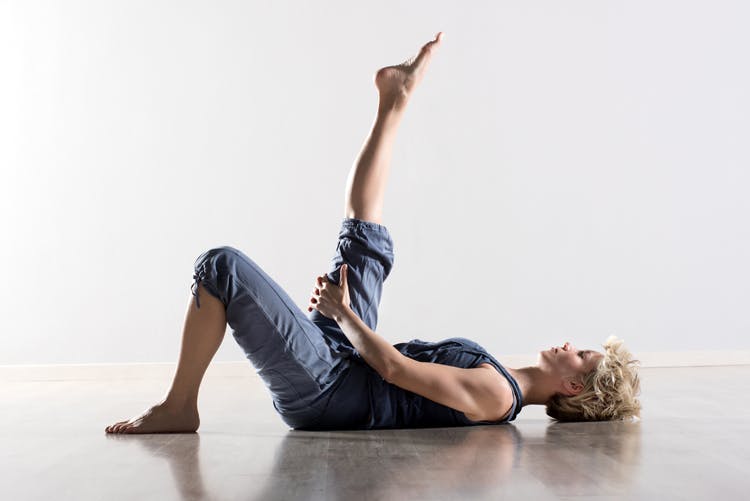
When muscles become stiff and rigid after a neurological injury like a stroke, it indicates a condition called spasticity. Treatment often involves exercise to help rewire the brain. However, when spasticity treatment exercises alone aren’t enough to produce results, other therapies such as Botox can be added to help relax the muscles.
You’re about to learn how spasticity treatment works, what exercises and therapies are available, and how you can maximize your chances of regaining mobility.
This guide has been updated to be even more comprehensive than before, so use the links below to jump straight to any section.
Table of contents:
- Causes
- Treatment
- Exercises
- Therapies
- Botox
- Medications
- Upper limb treatment
- Lower limb treatment
- Contractures
- Orthotics
What Causes Muscle Rigidity and Spasticity?
To understand what causes muscle rigidity and spasticity, let’s look at how your muscles typically function.
Under normal circumstances, your muscles and brain are in constant communication. Your muscles tell the brain how much tension they’re under, and your brain tells your muscles how and when to move. When a neurological injury such as a stroke damages the areas of the brain that control movement, it can impair the brain’s ability to communicate with the affected muscles.
As a result, your muscles may become “over-active” and remain in a state of involuntary contraction, formally known as spasticity. Spasticity is velocity-dependent, which means that the more rapidly a muscle is stretched, the more severely it will contract. However, spasticity can also be present at rest, as sometimes severe spasticity causes muscles to stay in a prolonged state of contraction.
Individuals with mild spasticity may experience muscle stiffness but can still move the muscle through its full range of motion. When spasticity is severe, however, muscles can become rigid and significantly affect mobility.
Furthermore, spasticity can affect any area of the body. Sometimes a person’s hand may become clenched in a fist, their arm may curl into their chest, or their toes may curl under. When spasticity is severe it can be painful and functionally limiting, making treatment even more important.
What Are the Goals of Spasticity Treatment?
There are generally two types of spasticity treatment: exercises that address the root issue causing spasticity and medications that address muscle tightness as a symptom. Both can play equally important roles in your recovery.
First, spasticity treatment exercises work by addressing damage to the nervous system. When exercises are repeated, it stimulates the brain and sparks neuroplasticity, which is the mechanism the brain uses to rewire itself.
Spasticity is caused by miscommunication between the brain and muscles; and spasticity treatment exercises directly improve this communication through neuroplasticity. When the brain and muscles can communicate with each other again, the brain can tell the affected muscles to relax and contract when appropriate.
Practicing spasticity treatment exercises on a daily basis can provide the brain with the stimulation it needs to rewire itself and promote adaptive changes. However, it can take some time for this rewiring to occur. This is where other spasticity treatments can help.
Certain medications like Botox and baclofen help address the symptom of spasticity. However, these drugs do not promote neuroplasticity. Instead, they temporarily relieve the symptom of muscle tightness.
Because the results are temporary, medications often work best when they are used to create a window of opportunity to complete daily rehabilitation exercises that focus on promoting neuroplasticity. That way, your short-term gains can make way for long-term results.
Spasticity Treatment Exercises
Spasticity treatment exercises are not designed to strengthen the muscles — at least, not primarily. Instead they are designed to activate neuroplasticity and improve the communication between your brain and muscles. Over time, this helps spasticity subside and allows your affected muscles to remain relaxed unless functionally contracting.
Because everyone experiences spasticity differently, a personalized approach to treatment is ideal. What works for some may not be as effective for others. Therefore, it is recommended to work with a team of rehabilitation specialists to optimize your recovery outcomes. Below, we’ll discuss some of the spasticity treatment exercises for stiff muscles after stroke:
Physical Therapy Exercises
Physical therapists specialize in stimulating the mind-body connection through exercise. Your PT can assess where spasticity is affecting your mobility and select helpful spasticity treatment exercises for you to practice.
Often, your PT works with you in the clinic, where they may use a combination of exercise, modalities, and manual therapy techniques. They will also recommend exercises for you to do on your own at home. These are essential to complete, as neuroplasticity is promoted through repetitious tasks. Completing home exercises increases how often the brain is stimulated to make adaptive changes.
For example, you can target spasticity in the hips with a seated marching exercise:
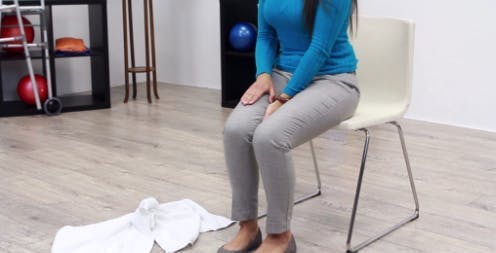
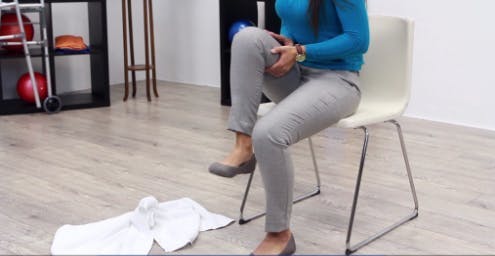
As you can see, this leg exercise is not designed to strengthen the muscles. Instead, it’s a therapeutic stretching movement that helps stimulate the brain when repeated on a regular basis.
Occupational Therapy Exercises
When spasticity affects your ability to accomplish everyday activities, that’s where an occupational therapist can help. Your OT will have you practice everyday activities to spark neuroplasticity, or they may teach you how to use adaptive tools to help you become more functional and independent after a stroke.
For example, you can target spasticity in the hand by practicing an everyday activity like pinching:
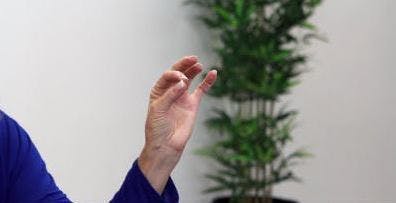

The ability to pinch and grasp objects is important for many of the activities of daily living such as getting dressed or brushing your teeth.
Passive Exercises
When spasticity is severe, or when post-stroke paralysis is involved, you may find it difficult to do active therapy exercises. This is where passive exercises come into play. By assisting your affected muscles through the movement, you can still activate neuroplasticity and encourage the brain to rewire itself. With enough repetition, you may regain some movement.
For example, you can target spasticity in the wrist by practicing a hand exercise passively.
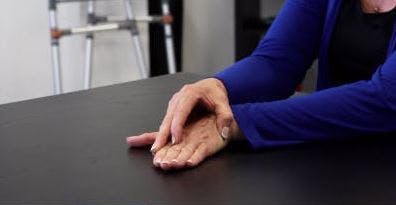
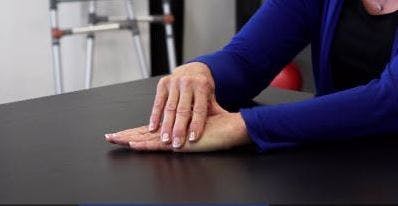
In this exercise, you can use your non-affected hand to move your affected hand through the exercise. This passive movement helps stimulate the brain and encourages spasticity to subside over time.
Range of Motion Exercises
Regardless of the severity of your spasticity, it’s important to move your affected muscles safely through their range of motion multiple times a day. Stretching is important for preventing spasticity from getting worse, along with preventing other post-stroke complications like pressure sores (if you’re bedridden or use a wheelchair regularly). Never stretch to the point of pain.
Therapies to Supplement Spasticity Treatment Exercises
Now that you know the various types of spasticity treatment exercises, let’s discuss two therapies that you can use in conjunction with exercises to enhance your results.
Electrical Stimulation
Electrical stimulation is a type of therapy where electrical currents are applied to the affected muscles through pads that attach to the skin. These electrical currents help stimulate the affected muscles, and promote their communication with the brain even more. In fact, combining electrical stimulation with rehab exercise has been shown to create better results than just exercises alone.
Talk to your therapist to see if it’s a good fit for you and learn where to place the electrodes. Do not use electrical stimulation if you have a pacemaker.
Electro-acupuncture
Acupuncture is an alternative treatment that comes from Traditional Chinese Medicine. It involves placing thin needles into specific “acupoints” on the body. When appropriate, a practitioner can apply electrical stimulation to the needles after they are inserted (electro-acupuncture). Electro-acupuncture has been shown to help reduce spasticity when combined with exercise.
It’s important to note that both electrical stimulation and electro-acupuncture are more effective when combined with rehab exercise, which further illustrates the important of spasticity treatment exercises.
When Is Botox Appropriate for Spasticity?
If you struggle with severe spasticity, then you may have difficulty doing exercises because your muscles will be too stiff. To help loosen things up, talk to your doctor or therapist about Botox injections.
Botox is a nerve block that helps temporarily relieve spasticity. Although the effects will wear off after 3-6 months, you can use the short-term reduction in muscle tightness to practice daily spasticity treatment exercises.
This will address the root problem of disrupted communication between the brain and muscles and encourage long-term improvement.
Other Medications and Procedures for Spasticity
Muscle stiffness and spasticity can also be treated with medications like baclofen, which is a muscle relaxant. It acts on the spinal cord and nerves to improve muscle movement.
This medication can be taken orally, or you can get a pump surgically implanted that releases a continuous supply. It’s called an intrathecal baclofen pump, and you can talk to your doctor to see if it’s a good fit for you.
Side effects from these medications can be severe, which makes a strong case for using the short-term relief provided to practice spasticity treatment exercises for long-term improvements.
There is a surgical procedure for spasticity called a rhizotomy where the surgeon permanently cuts the nerve rootlets in the spinal cord that are sending abnormal signals to the muscles. It’s predominantly used for individuals with cerebral palsy.
The effects are less studied but generally positive for spasticity in individuals with neurological injuries other than CP, such as stroke, traumatic brain injury, and spinal cord injury.
Surgery is permanent and should be carefully considered after other options have been exhausted. Now that you understand the various spasticity treatments available, let’s talk about how to apply them to upper limb and lower limb spasticity.
Upper Limb Spasticity Treatment
Sometimes spasticity affects the upper limb, including the hand, wrist, and arm. Fortunately, there are many spasticity treatments available.
In addition to rehabilitative therapies, Botox is approved by the FDA for upper-limb spasticity treatment. If you would like some relief, talk to your doctor about getting Botox injections for your affected muscles.
Be sure to use the temporary relief to practice daily spasticity treatment exercises at home. If you struggle with sticking to a home therapy program, you can use motivating equipment like Flint Rehab’s FitMi.
The FitMi takes 40 therapeutic rehab exercises and turns them into an interactive experience. You can target specific muscles groups like the arm and hand. Many individuals with spasticity have seen improvement by using FitMi on a daily basis.
Here’s what some survivors with spasticity said about FitMi:

“I had a stroke 19 months ago, and I have hemiplegia on the right side and both my leg and arm were flaccid. My right shoulder, arm, and hand are mostly limp, so when I read about FitMi I figured it could only help. When it arrived I got it all installed, and started with my right arm at five minutes. Since my right side is limp, I have to use my left arm to help, but it really seems to be improving. My severe spasticity fights all the way, but I can feel the improvements in my right upper body. I’ve reached level 74 on the right arm!”
–William Z.
“My Dad wasn’t too motivated to do any exercises at home until I bought FitMi for him. He loves music and looks like it distracts him from pain while exercising. We’ve been using FitMi for over a month and his right arm spasticity is almost gone, we exercise daily.”
-Liudmila A.
William demonstrates the power of passive exercise while Liudmila shares the power of daily practice. No matter how you get your spasticity treatments exercises done, consistency is the key.
Lower Limb Spasticity Treatment
When spasticity affects the lower limbs, it can make it difficult to walk and put you at greater risk of falling. Therefore, exercising the legs is an essential step for lower limb spasticity treatment. A great way to do this is through physical therapy.
If you’re eager to add more to your regimen, talk to your doctor about Botox, which is also FDA-approved for lower limb spasticity. Also, there is evidence that electro-acupuncture can be an effective add-on to your spasticity treatment exercises. In a meta-analysis of over 1,425 patients with spasticity, electro-acupuncture was shown to help with both upper and lower limb spasticity.
But if you want to optimize your ability to reduce spasticity in the legs, the key is exercise. Do your best to gently stretch your legs multiple times a day, and practice rehab exercises for the legs.
If you can walk with a walker or cane, try to walk daily to get some task-specific exercise. If you can’t walk yet, then have your therapist or a trained caregiver help you exercise your legs passively. The FitMi also contains exercises that target the legs and feet for a structured approach.
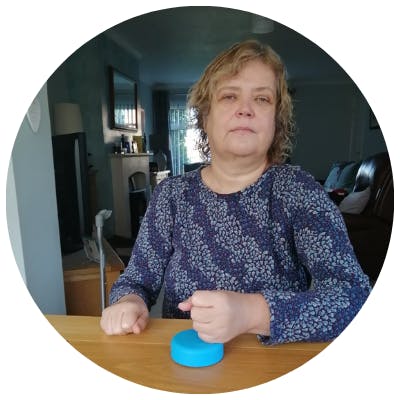
“FitMi was easy to install and run. I wanted to focus on walking but I do all the exercises and quickly noticed an improvement in my stiff and awkward shoulder and weak hand. I also felt stronger when standing – steadier, walking quicker and more evenly. My foot is moving better. I can stand still for longer and my puppy no longer feels like she will topple me over when she jumps up!”
-Jill J.
Practice, practice, practice. Using and moving your legs on a consistent basis helps stimulate the brain and spark neuroplasticity. This is the best way to treat spasticity in the legs long-term.
[Related: Because walking is crucial for the activities of daily living, we created an extensive guide on how to regain the ability to walk if you’re working towards that goal.]
Contractures: When Spasticity Goes Untreated
By now, you understand the importance of exercise and how to add other therapies, such as electro-acupuncture, to increase your results. It’s also important to understand what happens when spasticity treatment is neglected.
If you don’t stretch or exercise your spastic muscles on a daily basis, then spasticity can progress into contractures, which are characterized by extreme stiffness in the muscles, joints, or connective tissue. Individuals with very limited mobility may neglect their affected limbs, which is another risk factor for the development of contractures (and also learned nonuse).
Contractures can be painful and further limit your range-of-motion. Individuals may experience contractures throughout their body, including in their hand, resulting in a clenched hand, or in the shoulder, resulting in frozen shoulder.
If you struggle with contractures, it’s important to start gently stretching your affected muscles. You may benefit from a hand splint or even stretching your hand out on a table.
Remember that spasticity increases the faster the muscles is stretched, so work slowly and gently. Never stretch to the point of pain. When contractures are involved, it’s a great idea to work more closely with a therapist. They can recommend other therapies or medications, such as orthotics or Botox when appropriate, and recommend exercises to do at home.
When Are Orthotics Appropriate?
Orthotics involve various casts and splits that help stretch spastic muscles. Your therapist may recommend orthotics if they are appropriate for you.
A common example is a hand splint. For those with spasticity resulting in a clenched hand, a splint can help prop open the hand to keep the fingers in an extended position for an extended period of time.
There are other types of orthoses available that target other muscle groups. For instance, an ankle-foot orthotic, which is commonly used for foot drop, can help stretch the calf and prevent contractures in the calf muscles.
As with all add-on therapies for spasticity, it’s important to combine the use of an orthotic with spasticity treatment exercises. Stretching and splinting alone is not enough to treat spasticity long-term. Instead, outcomes improve when orthotics and stretching are combined with additional therapeutic interventions.
Finding Relief from Spasticity
Spasticity involves rigid muscles and muscle stiffness that stems from miscommunication between the brain and muscles after a neurological injury. Exercise is a great treatment for spasticity because it sparks neuroplasticity and helps repair the communication between the brain and muscles.
There are many therapies available that you can supplement with your spasticity treatment exercises such as Botox and electro-acupuncture. You will see the best results when these extra therapies are added on top of your daily exercise regimen, which targets the root issue.Medically reviewed by Elizabeth Denslow, OTR/L — written by Flint Rehab Elizabeth Denslow, OTR/L, CLT is an occupational therapist with experience working in outpatient and home health settings.



